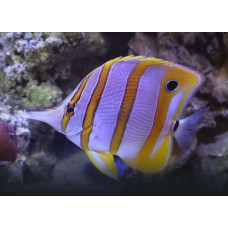Latin name
Chelmon rostratus
Other name
Beaked coral fish
Identification
Copper banded butterflyfish have a long snout. Juveniles look like adults.
Features of fish fins
Dorsal fin has 9 hard and 28-30 soft rays. Anal spines: 3; anal soft rays: 19 - 21.
Fish colouring
Copper banded butterflyfish are easily identified by their yellow stripe.
Distribution
The range extends from southern Japan and Taiwan through the entire Coral Triangle, northern Thailand, the Andaman, Nicobar and Solomon Islands and northern Australia. The area of the range is approximately 17,300 km².
Habitat
A tropical marine species that prefers brackish water. Natural habitats are along rocky shores, coral reefs and in estuaries in brackish seawater. Depth ranges from 1 to 41 metres.
Size
Maximum length of this species is 20.0 cm. Maximum recorded age: 10 years.
Behavior
A non-migratory species. They live alone or in pairs. They are territorial.
Food and feeding habits
The Copperband Butterflyfish uses its long snout to forage for food, which consists of a variety of small aquatic animals, usually found between rocks or in crevices, which form the basis of its diet.
Reproduction
They form pairs during the breeding season.
Fishing
Fished for the aquarium trade, but there is no data on the extent to which this affects population numbers. There are no other serious threats to the species.
Relationship with a person
Harmless. Copper banded butterflyfish can be found in the aquarium trade.
| Classification | |
| Phylum | Chordata |
| Class | Actinopterygii |
| Squad | Acanthuriformes |
| Family | Chaetodontidae |
| Genus | Chelmon |
| Species | C. rostratus |
| Features | |
| Conservation status | Least Concern |
| Habitat | Pelagic |
| Life span, years | 10 |
| Maximum body weight, kg | No information |
| Maximum length, cm | 20 |
| Sailing speed, m/s | No information |
| Threat to people | Not edible |
| Way of eating | Planktonophage |
Copperband butterflyfish
Tags: copperband butterflyfish

